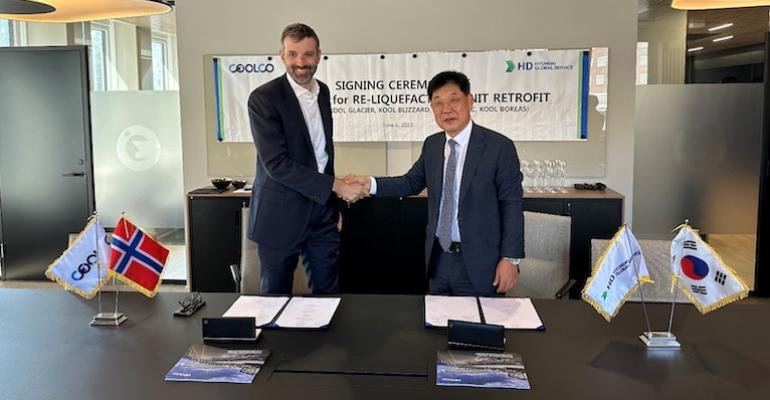HD Hyundai Global Service, a Hyundai group service subsidiary, has been chosen to oversee design, supply, and installation of the Air Liquide reliquefaction units at a cost of $10 million per vessel.
The deepsea LNG fleet, comprising ships of more than 40,000 cubic metres, now consists of about 650 vessels, a large number of which do not have boil-off management systems. These installations cut emissions by enabling boil-off gas to be reliquefied and used as fuel or returned to cargo tanks.
For ships without such systems, boil-off gas must be burnt off or simply emitted to air. Not only does the volume of cargo reduce over the course of a voyage, but the lightest and often most valuable components of LNG may boil off first. The value of loaded cargoes can therefore fall over the course of a voyage before the LNG is actually sold at its destination, based on energy content.
On top of this LNG carriers in the existing fleet will already fall into category D or E of the International Maritime Organization’s CII ratings, according to experts. Steam turbine vessels, of which there are about 240 in the fleet today (45 of which are more than 25 years old) already trade at a substantial discount compared with LNG carriers equipped with more modern propulsion systems because they consume 20-50% more fuel. These ships are likely to be amongst those that receive the lowest CII assessments.
The HD Hyundai Global Service liquefaction units that CoolCo has chosen will be effective mainly for LNG carriers with tri-fuel diesel-electric (TFDE) propulsion or two-stroke dual-fuel (DF) engines. In a statement, the company revealed that it is receiving enquiries for its systems from various potential customers.
At the IMO’s 78th MEPC meeting last year, it was agreed that a CII correction factor could be applied to LNG carriers for the fuel consumption equivalent to the power required to operate cargo liquefaction systems. This is likely to prove an additional incentive for owners to install such systems, particularly since methane emissions will be included in CII assessments from the beginning of 2026.
Although the LNG orderbook now consists of more than 330 ships, representing over half of the existing fleet, analysts point out that the relatively small number of shipyards capable of building these sophisticated ships are, in practical terms, full until 2027. Newbuilding prices have climbed dramatically, with the cost of a new 172,000 cubic metre ship, the most popular size, now more than $260 million, up from about $190 million in 2020.
Another key feature of this sector is rising demand for floating storage and regasification units (FSRU), generally a far quicker and significantly cheaper means of boosting LNG import capacity. Two of five new FSRU installations in Germany, for example, are already in operation; others are under development. But demand for FSRU terminals is evident in many regions, and ageing LNG carriers offer a fast-track option.
So, all of the ships currently in operation are needed as global demand for LNG continues to soar. In practical terms, therefore, shipyards and repair facilities capable of undertaking projects such as the CoolCo retrofit initiative should be gearing up for a wave of upgrade business to support the operating efficiency of LNG carriers in the years ahead.
In a separate development, HD Korea Shipbuilding & Offshore Engineering signed an agreement with Lloyd’s Register, Norway’s Knudsen OAS Shipping and Hyundai Heavy Industries, to carry out a carbon emissions assessment over the entire life of a 174,000 cubic metre LNG carrier, specifically a new vessel to be delivered to Knudsen this month.
In what is claimed to be a world first, the company will measure carbon dioxide emissions from raw material procurement, to vessel construction, operation and eventual recycling – in other words, the ship’s carbon profile ‘from cradle to grave’.
Copyright © 2024. All rights reserved. Seatrade, a trading name of Informa Markets (UK) Limited.
Add Seatrade Maritime News to your Google News feed.  |

